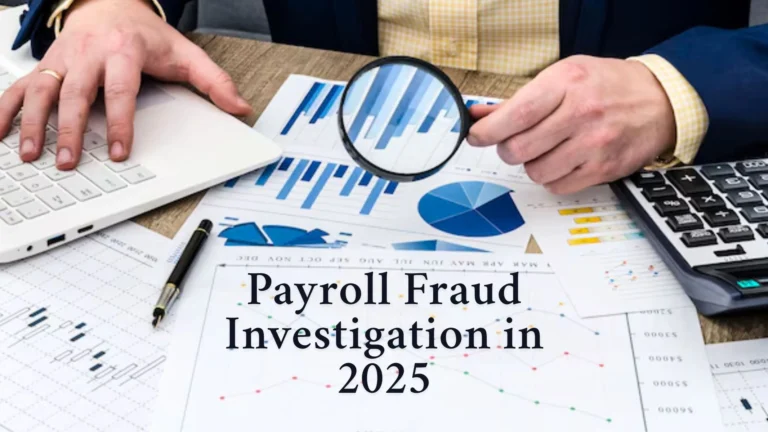Payroll Fraud Investigation in 2025: A CA’s Guide to Catching Red Flags Early

Introduction to Payroll Fraud Investigation
In 2025, payroll fraud remains one of the most underreported yet financially damaging corporate frauds in India. Whether you’re a Chartered Accountant (CA), CA student, or an internal auditor, understanding how to investigate payroll fraud is crucial—not just for compliance, but for protecting organizational integrity.
This guide outlines how forensic auditors in India approach payroll fraud investigations, step-by-step, with practical insights tailored for finance professionals like you.
What Is Payroll Fraud?
Definition & Indian Context
Payroll fraud occurs when employees or payroll staff manipulate salary disbursements for personal gain. In India, where many companies still operate with limited automation and segregated controls, the payroll process is particularly vulnerable.
It’s not just about fake employees—fraud can hide in overtime logs, inflated bonuses, or unauthorized changes in HR systems.
Why Forensic Audits Are Crucial in 2025
The rise of hybrid work, outsourced payroll, and digital salary processing has introduced new loopholes. SMEs often lack internal controls, and even large companies are struggling with audit gaps. These conditions make 2024 a critical year for payroll fraud detection.
Common Types of Payroll Fraud in India
Understanding the forms fraud can take is the first step to spotting it.
Ghost Employees
Fake employees who receive salaries—often created by insiders with system access.
Falsified Hours or Attendance
Staff log extra hours or manipulate biometric systems to claim higher wages.
Salary Inflation & Bonus Manipulation
HR or payroll managers inflate salaries or allocate unearned bonuses to select employees.
Unauthorized Changes in Employee Records
Modifying bank details, PAN numbers, or grades to reroute funds or unjustly raise compensation.
Red Flags and Early Warning Signs
Effective payroll fraud investigation begins by identifying red flags.
Duplicate Employee IDs
Same PAN or Aadhaar used for multiple employee profiles—often an indicator of ghost employees.
Excessive Overtime Trends
Sudden spikes in overtime payments, especially in non-production roles.
Suspicious Payment Patterns
Round figure payouts, payments on weekends, or last-minute payroll adjustments without approval.
Access Given to Too Many Payroll Staff
Multiple users with admin access to payroll systems increases manipulation risks.
Read also: Top 10 Red Flags Every Auditor Should Know
Step-by-Step Guide: How Forensic Auditors do Payroll Fraud Investigation
Here’s how a trained forensic auditor dissects payroll fraud in real-world Indian audits.
1. Planning the Audit Scope
Define scope, time period, and systems to audit. Focus on departments with high payroll complexity or previous anomalies.
2. Analyzing Payroll Records & Anomalies
Look for inconsistencies in salary structure, sudden hikes, or irregular bonus disbursements.
3. Interviewing HR/Payroll Staff
Ask specific questions about payroll workflows, access control, and manual overrides.
4. Using Data Analytics Tools
Apply pivot tables, Excel macros, or audit software to analyze thousands of transactions quickly.
5. Cross-Verifying with Attendance Logs
Compare salary records with biometric or manual attendance. Discrepancies often reveal false overtime or ghost employees.
6. Documenting Findings and Evidence
Maintain a clear trail with screenshots, logs, emails, and interviews for legal defensibility.
Tools & Techniques Used in Payroll Fraud Investigation
Excel & Pivot Tables
Ideal for slicing payroll data by department, employee, or pay grade.
Audit Trail Analysis
Track changes in payroll systems—who changed what and when.
ERP System Red Flag Reports
Many ERPs have built-in reports that highlight duplicate records, sudden spikes, or access violations.
Benford’s Law Application
A statistical method to detect anomalies in naturally occurring data like salary figures.
Conclusion
Payroll fraud may seem like a niche domain, but it’s a high-risk area with real financial consequences. As a CA or finance student, mastering forensic payroll audits not only sharpens your analytical skills but positions you as a trusted advisor in corporate governance.
Whether you’re preparing for a CA final exam or leading internal audits, knowing how to detect, investigate, and report payroll fraud gives you an edge.